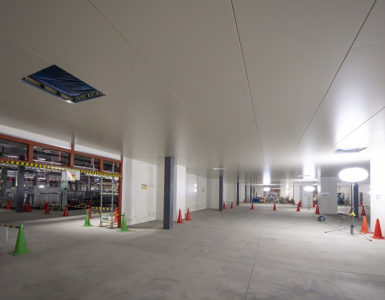Alpine 4 Holdings (ALPP) subsidiary elecjet releases the results from the Battery Innovation Center (BIC) on its AX class solid-state batteries.
Alpine 4 Holdings, Inc. (Nasdaq: ALPP), a leading operator and owner of small market businesses announced that its subsidiary, ElecJet, has released specifications on third-party testing of its AX Class of Solid-State Batteries.
ElecJet, earlier this month, engaged the Battery Innovation Center (BIC) in Newberry, Indiana to have a third-party verification of the specifications of its AX Class of Solid-State Batteries that ElecJet has already confirmed in its laboratory.
ElecJet has engaged the BIC to verify the results of the G-AX Class as well, later in 2022. The AX Battery Class is a Ceramic Oxide solid-state battery and comes in the form of a 31Ah Solid-State Battery and a 10Ah Solid-State Battery. All of the AX and G-AX Classes are true solid-state batteries and are not semi solid-state batteries.
🔥 What about we co-host a webinar? Let's educate, captivate, and convert the battery economy!
Batteries News is the global go-to online magazine for the battery industry, we can help you host impactful webinars that become a global reference on your topic and are an evergreen source of leads. Click here to request more details
ElecJet engaged the BIC to perform several types of testing from verification of its charge capabilities to energy density / power density, to induced failure point testing.
The BIC tested two versions of the AX 31Ah. These two subclasses are designed for different market segments.
- The AX-01 is an ultra-safe version that can withstand a variety of survivability use cases. The AX-01 has a slightly different material composition that enables its amazing survivability characteristics. The BIC confirmed that the AX-01 withstood being punctured, then folded, and finally crumpled while still holding a charge. The cell was then put through a temperature destruction test where the cell survived to a temperature of 410 degrees Fahrenheit (210 degrees Celsius). Details of the tests are described below:
- Nail Puncture Test: The AX-01 was punctured by a 3mm diameter nail. The nail was left inside the battery, purposely causing the battery to short, of which it did for over an hour while being suspended in the air. The battery’s temperature fluctuated but would hover at around 98.6°F (37°C) near the end of the hour with a maximum measured temperature of 101.76°F (38.76°C). After, the battery was lowered back on to the metal surface for the nail to be removed and the battery quickly returned to room temperature. One amazing feature of the battery was that during the entirety of the test, the AX-01 was holding voltage and remained functional. Note: Traditional lithium batteries would instantly catch on fire and go into thermal runaway the moment the battery was punctured.
- Fold/Crumple Test: After the puncture test, the AX-01 was folded over its long side (AX-01 is a long rectangular shape) by a mechanical actuator. After it was folded to the point that both ends were touching each other, the battery was attempted to be folded over again by its short side. After being folded with as much force as the mechanical actuator could press out, the battery remained functional throughout the entire process and remained at room temperature. Note: Standard lithium batteries would normally catch on fire after being folded at even a small angle.
- Thermal Heat Test: The battery was placed in an oven and the oven would slowly and constantly increase in temperature to test the battery’s heat exposure breaking point. The temperature of the battery was brought up to 428°F (220°C) before thermal runaway occurred creating a new BIC record. Once the battery eventually caught fire, the fire was unlike other thermal runaways where a battery spews a stream of fire from a concentrated point, but rather was much more contained to the surface area across the battery. Note: Typical lithium batteries would have a thermal runaway at 266°F (130°C) and the previous highest recorded temperature before thermal runaway on cells of similar capacity, with fielded chemistries, at the BIC was 302°F (150°C).
The BIC confirmed that the AX-01 measured a discharge energy of 111.41Wh at a C/2 rate (measured 31.70 Ah)).
At a nominal volume of 0.17571 Liters for each cell and a nominal mass of 0.395 kg, this translates to 634Wh/L and 282Wh/kg of energy densities which are both dramatic improvements over current battery technology.
* The AX-01 also has a designed commercial cycle life of over 1,200 charge cycles.
- The AX-02 is an energy dense cell that also has a high degree of survivability but trades some of the safety material features of the AX-01 for much higher power densities and higher life cycles.
The BIC confirmed that the AX-02 has the capability to charge at 4C. This means that the battery can fully charge in just 15 minutes. The AX-02 is also capable of 7C discharging and over 2,400 life cycles, both of which are currently in the process of being confirmed by the BIC.
The BIC also confirmed that the AX-02 measured a discharge energy of 113.213Wh at a C/2 rate (measured 31.4 Ah).
At a nominal volume of 0.17571 Liters for each cell and a nominal mass of 0.395 kg, this translates to 644Wh/L and 287Wh/kg of energy densities which are both dramatic improvements over current battery technology.
READ the latest Batteries News shaping the battery market
Alpine 4 Holdings (ALPP) Subsidiary ElecJet Releases the Results from The Battery Innovation Center (BIC) On Its AX Class Solid-State Batteries, PHOENIX, March 25, 2022








